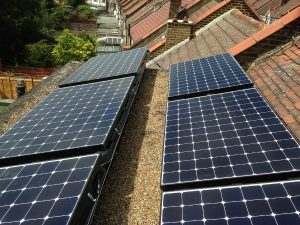Information provided by Andy Reynolds of the Ecolodge

This piece of kit is the interface between an array of solar panels and the national grid. It takes the direct current (DC) electricity generated from roof or ground mounted solar panels and changes it into AC electricity at a voltage that is suitable to be fed directly into the grid. Imagine a unit about the size of a small suitcase that is fixed to a suitable internal wall and is gently humming like Granny when baking or gardening. When the sun shines on your panels it starts working and in the evening it shuts off.
The size and specifications of the unit are chosen to match the number of panels that can be fitted on your property. The grid tie uses a technology called maximum power point tracking to get the best out of the system, and the larger units have 2 tracking systems so that 2 separate sets of panels (strings) can be connected to it. This is beneficial for several reasons, primarily to reduce the effects of shade on any of the panels, and secondly so the 2 individual strings can face differing directions and still work without having an effect on the other string. An instance of this is when you have a roof that faces east and west, so both the morning and evening sun is captured.
Just to note here that when a panel within a string is shaded it can have a dramatic reducing effect on the output of that string, so shade is a major consideration when fitting panels. The panels have a bypass system so that power from the rest of the generating panels can bypass the shaded panel. This reduces the overall voltage but the power point tracking can deal with that.
The grid tie feeds into the wiring system in your property through a meter that records the cumulative total generation and provides electrical power up to the amount that is being generated at the time, if the demand is higher than the generation the extra is seamlessly drawn from the grid. At night all the power comes from the grid unless you have a battery backup system, which is rare at the moment, but will become increasingly popular. During the day when generation exceeds consumption then the excess power is fed into the grid where it goes of to power somebody else’s consumption.
In the photo of an SMA inverter you can see there is a display on the unit showing what is being generated now. Below this is the DC and AC isolating switches, note that the AC must always be switched off first to prevent damage. The DC switch is there for serious repairs and should not be fiddled with.
Powering an immersion heater that is normally 3 Kw from your grid tied solar array is difficult because the immersion will frequently demand more that your generation at that time. For instance on a slightly cloudy day you may be generating 1.2 Kw, but the immersion will always demand 3 Kw whenever the thermostat switches it on, so the extra comes from the grid and you will have to pay for it. There are however several pieces of kit that feed only home generated power into the immersion heater, and prevents that demand for extra power from the grid. Here is a video about fitting and use of the Solamiser equipment:
The grid tie is permanently connected to the grid through your consumer unit (fuse box) and when the grid fails or your trip switch is off then no power is generated. There are 2 reasons for this, first if your grid tie was to keep working it would be instantly overloaded as it would be trying to power all the houses in the surrounding area, and the grid tie takes it’s AC frequency and voltage level from the grid, so without the grid power it wouldn’t have a clue what to do. The goblins inside would have no orders and could create havoc.
For a huge amount of extra information on the subject of powering your home from solar see Wind & Solar Electricity.

